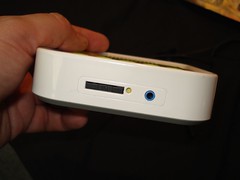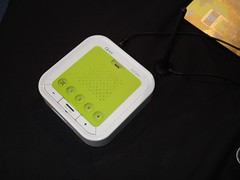You slip your normal SIM card in the slot - and leave this box at home. I guess I'd want to try it out on a trip when it didn't matter too much if my phone wasn't working.
So what's the best equipment for storytelling, especially if you're in broadcasting? These are the reports on my safaris. Interested in your road-trip experiences too.
Tuesday, February 20, 2007
SkyQube
Now this is interesting if you do a lot of travel. You connect it up at home and put the SIM card of your mobile into it. When you get to your destination you buy a cheap prepaid SIM that allows you to receive calls for free. This green box uses Skype to beat the roaming charges levied in other countries. Also features a recording function and callback. Cost? About 300 bucks to start with. Might be worth experimenting with for reporters in "difficult" countries? More details at www.Qoolabs.com. Seen at the 3GSM conference in Barcelona last week.
Saturday, February 10, 2007
DRM85CSHEETV31.pdf (application/pdf Object)
DRM85CSHEETV31.pdf (application/pdf Object)
I see that HHB in the UK is now selling a cardiod version of the integrated Flashmic 1GB flash recorder. The older one uses an omnidirectional mike. This one is better for noisy surroundings, but less handy for doing general interviews because you have to make sure it is pointing accurately or you'll hear nothing off mike. I wonder why they can't put 2GB in the device now for the same price. 1 GB is super cheap these days.
I see that HHB in the UK is now selling a cardiod version of the integrated Flashmic 1GB flash recorder. The older one uses an omnidirectional mike. This one is better for noisy surroundings, but less handy for doing general interviews because you have to make sure it is pointing accurately or you'll hear nothing off mike. I wonder why they can't put 2GB in the device now for the same price. 1 GB is super cheap these days.
Monday, February 05, 2007
Power Alternatives

So you're out in the middle of nowhere in a jeep (or on a plane). What about charging your recorder, laptop, camera, moviecamera, torch, etc. You could take spare batteries for everything, or get one of these inverters for around 100 dollars. It also has USB power outlets to charge iPods, Blackberries, some phones. Haven't seen 220 volt models. Doesn't matter for most travel devices these days - 110 volts is fine.
Sunday, February 04, 2007
EJamming nears Launch

Interesting to see how musicians are collaborating on line. Just a few weeks ago, noticed a demo of eJamming. The blurb on the site reads....
Say you’re putting a band together and you can’t find a killer bass player in your town. Or you’re sitting there sequencing a great piece of music but your drumming sucks and you’re no Eddie Van Halen on guitar. Or your old band mates now live in Seattle, New York and Nashville and you’d kill to play together again. What’s the answer?
Just plug any digital instrument that’s enabled for GENERAL MIDI – a MIDI-enabled keyboard, a MIDI-enabled guitar or MIDI-enabled bass, MIDI-enabled drums, or a MIDI-enabled wind-controller -- into your PC or Mac computer, fire up the eJamming® Studio and we’re connecting you over the Internet to a whole world of musicians across town – or across the ocean.
In Sync. In Real Time. Or in as close to real time as the laws of physics allow.
And now that eJamming Studio comes with our own exclusive Sonic Implants Sound Set inside – it’s even easier to create and collaborate together over the Internet!
Friday, February 02, 2007
MicroHDTV Camera

A novel miniature camera allows viewers to enjoy a new live experience and watch a ski jump or a car race in high resolution from the actor’s perspective. The camera is so tiny that it even fits inside the cramped cockpit of a racing car. Until recently, this could only be done in standard TV resolution. Now these images have made the leap to ‘high-definition TV’ (HDTV), thanks to a mini-camera developed by researchers at the Fraunhofer Institute for Integrated Circuits IIS in Erlangen. Several licensees will soon be putting the camera into series production.
Measuring 4 by 4 by 8 centimeters, the camera is smaller than a bar of soap and can even be accommodated in a cramped racing-car cockpit or a ski jumper’s helmet. »The MicroHDTV model is one of the smallest HDTV cameras currently available,« says Stephan Gick, group leader at the IIS. »We achieved this chiefly by taking two different approaches: The camera’s electronics have a very low power loss, which means that little heat is generated and the housing can thus be kept very small. By using highly integrated parts, we were able to fit all of the components such as the image sensor, the analog-to-digital converter, the color processor and several interfaces into the tiny space available inside the camera.«
With its format of 1920 x 1080 pixels and a variable frame rate of up to 60 frames per second, the camera meets all the requirements expected of a professional HDTV production. All parameters – such as color settings, white balance, image format and frame rate – can be controlled using the integrated software. All it takes is to open a web browser, connect the camera to the notebook via a local network and set the desired parameters. »Because the camera is so small and can be controlled via the Internet, it can deliver pictures of scenes that could not be viewed in the same way before – for example, recordings of sports events or applications that require the camera to be installed in difficult-to-reach places,« says Gick.
Another of the camera’s advantages is that it can be operated using standard optical systems. The MicroHDTV camera will be on display at the CeBIT trade fair (Hall 9, Stand B36), which will take place in Hanover, Germany from March 15 to 21 2007.
More information from Dipl.-Ing. Stephan Gick, Phone: +49 9131 776-521
Fax: +49 9131 776-598
Fraunhofer-Institut für Integrierte Schaltungen IIS
Am Wolfsmantel 33
91058 Erlangen, Germany
Subscribe to:
Posts (Atom)

